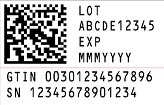FULL PRESCRIBING INFORMATION
1 INDICATIONS AND USAGE
1.1 Chemotherapy-Induced Nausea and Vomiting in Adults
Palonosetron Hydrochloride (HCl) Injection is indicated for:
• Moderately emetogenic cancer chemotherapy – prevention of acute and delayed nausea and vomiting associated with initial and repeat courses
• Highly emetogenic cancer chemotherapy – prevention of acute nausea and vomiting associated with initial and repeat courses
2 DOSAGE AND ADMINISTRATION
2.1 Recommended Dosage
Chemotherapy-Induced Nausea and Vomiting
The recommended adult dosage of Palonosetron HCl Injection is 0.25 mg administered as a single intravenous dose over 30 seconds. Dosing should occur approximately 30 minutes before the start of chemotherapy.
2.2 Instructions for Intravenous Administration
- Palonosetron HCl Injection is intended for direct intravenous administration without further dilution.
- Do not mix with other drugs.
- When applicable, flush the line with normal saline before and after administration of Palonosetron HCl Injection to ensure complete dosing and to avoid drug incompatibilities.
- Inspect Palonosetron HCl Injection visually for particulate matter and discoloration before administration.
3 DOSAGE FORMS AND STRENGTHS
Palonosetron Hydrochloride Injection is sterile, clear, and colorless:
• 0.25 mg palonosetron in 2 mL (0.125 mg/mL) in a single-dose vial
4 CONTRAINDICATIONS
Palonosetron HCl Injection is contraindicated in patients known to have hypersensitivity to the drug or any of its components [see Adverse Reactions (6.2)].
5 WARNINGS AND PRECAUTIONS
5.1 Hypersensitivity
Hypersensitivity reactions, including anaphylaxis, have been reported with or without known hypersensitivity to other 5-HT3 receptor antagonists.
5.2 Serotonin Syndrome
The development of serotonin syndrome has been reported with 5-HT3 receptor antagonists. Most reports have been associated with concomitant use of serotonergic drugs (e.g., selective serotonin reuptake inhibitors (SSRIs), serotonin and norepinephrine reuptake inhibitors (SNRIs), monoamine oxidase inhibitors, mirtazapine, fentanyl, lithium, tramadol, and intravenous methylene blue). Some of the reported cases were fatal. Serotonin syndrome occurring with overdose of another 5-HT3 receptor antagonist alone has also been reported. The majority of reports of serotonin syndrome related to 5-HT3 receptor antagonist use occurred in a post-anesthesia care unit or an infusion center.
Symptoms associated with serotonin syndrome may include the following combination of signs and symptoms: mental status changes (e.g. agitation, hallucinations, delirium, and coma), autonomic instability (e.g. tachycardia, labile blood pressure, dizziness, diaphoresis, flushing, hyperthermia), neuromuscular symptoms (e.g., tremor, rigidity, myoclonus, hyperreflexia, incoordination), seizures, with or without gastrointestinal symptoms (e.g., nausea, vomiting, diarrhea). Patients should be monitored for the emergence of serotonin syndrome, especially with concomitant use of Palonosetron HCl Injection and other serotonergic drugs. If symptoms of serotonin syndrome occur, discontinue Palonosetron HCl Injection and initiate supportive treatment. Patients should be informed of the increased risk of serotonin syndrome, especially if Palonosetron HCl Injection is used concomitantly with other serotonergic drugs [see Drug Interactions (7.1)].
6 ADVERSE REACTIONS
6.1 Clinical Trials Experience
Because clinical trials are conducted under widely varying conditions, adverse reaction rates observed in the clinical trials of a drug cannot be directly compared to rates in the clinical trials of another drug and may not reflect the rates reported in practice.
The safety of Palonosetron HCl Injection has been established from adequate and well-controlled studies of another intravenous formulation of palonosetron HCl [see Clinical Studies (14)]. Below is a display of the adverse reactions of palonosetron HCl in these adequate and well-controlled studies.
Chemotherapy-Induced Nausea and Vomiting
In clinical trials for the prevention of nausea and vomiting induced by moderately or highly emetogenic chemotherapy, 1374 adult patients received a single 0.25 mg dose of palonosetron HCl. Adverse reactions were similar in frequency and severity with intravenous palonosetron HCl and ondansetron or dolasetron.
The following is a listing of all adverse reactions reported by ≥ 2% of patients in these trials (Table 1).
Table 1: Adverse Reactions from Chemotherapy-Induced Nausea and Vomiting Studies ≥ 2% in any Treatment Group
|
Adverse Reaction |
Palonosetron HCl |
Ondansetron |
Dolasetron |
|
Headache |
60 (9%) |
34 (8%) |
32 (16%) |
|
Constipation |
29 (5%) |
8 (2%) |
12 (6%) |
|
Diarrhea |
8 (1%) |
7 (2%) |
4 (2%) |
|
Dizziness |
8 (1%) |
9 (2%) |
4 (2%) |
|
Fatigue |
3 (< 1%) |
4 (1%) |
4 (2%) |
|
Abdominal Pain |
1 (< 1%) |
2 (1%) |
3 (2%) |
|
Insomnia |
1 (< 1%) |
3 (1%) |
3 (2%) |
In other studies, 2 patients experienced severe constipation following a single palonosetron HCl dose of approximately 0.75 mg, three times the recommended dose.
In clinical trials, the following infrequently reported adverse reactions, assessed by investigators as treatment-related or causality unknown, occurred following administration of palonosetron HCl to adult patients receiving concomitant cancer chemotherapy:
Cardiovascular: 1%: non-sustained tachycardia, bradycardia, hypotension, < 1%: hypertension, myocardial ischemia, extrasystoles, sinus tachycardia, sinus arrhythmia, supraventricular extrasystoles and QT prolongation. In many cases, the relationship to palonosetron was unclear.
Dermatological: < 1%: allergic dermatitis, rash.
Hearing and Vision: < 1%: motion sickness, tinnitus, eye irritation and amblyopia.
Gastrointestinal System: 1%: diarrhea, < 1%: dyspepsia, abdominal pain, dry mouth, hiccups and flatulence.
General: 1%: weakness, < 1%: fatigue, fever, hot flash, flu-like syndrome.
Liver: < 1%: transient, asymptomatic increases in AST and/or ALT and bilirubin. These changes occurred predominantly in patients receiving highly emetogenic chemotherapy.
Metabolic: 1%: hyperkalemia, < 1%: electrolyte fluctuations, hyperglycemia, metabolic acidosis, glycosuria, appetite decrease, anorexia.
Musculoskeletal: < 1%: arthralgia.
Nervous System: 1%: dizziness, < 1%: somnolence, insomnia, hypersomnia, paresthesia.
Psychiatric: 1%: anxiety, < 1%: euphoric mood.
Urinary System: < 1%: urinary retention.
Vascular: < 1%: vein discoloration, vein distention.
6.2 Postmarketing Experience
The following adverse reactions have been identified during post approval use of another intravenous formulation of palonosetron HCl. Because these reactions are reported voluntarily from a population of uncertain size, it is not always possible to reliably estimate their frequency or establish a causal relationship to drug exposure.
Very rare cases (<1/10,000) of hypersensitivity reactions including anaphylaxis and anaphylactic shock and injection site reactions (burning, induration, discomfort and pain) were reported from postmarketing experience of palonosetron HCl 0.25 mg in the prevention of chemotherapy-induced nausea and vomiting.
7 DRUG INTERACTIONS
7.1 Serotonergic Drugs
Serotonin syndrome (including altered mental status, autonomic instability, and neuromuscular symptoms) has been described following the concomitant use of 5-HT3 receptor antagonists and other serotonergic drugs, including selective serotonin reuptake inhibitors (SSRIs) and serotonin and noradrenaline reuptake inhibitors (SNRIs). Monitor for the emergence of serotonin syndrome. If symptoms occur, discontinue Palonosetron HCl Injection and initiate supportive treatment [see Warnings and Precautions (5.2)].
8 USE IN SPECIFIC POPULATIONS
8.1 Pregnancy
Risk Summary
There are no available data on palonosetron HCl use in pregnant women to inform a drug-associated risk. In animal reproduction studies, no effects on embryo-fetal development were observed with the administration of oral palonosetron HCl to rats and rabbits during organogenesis at doses up to 1894 and 3789 times the recommended human intravenous dose, respectively [see Data].
The estimated background risk of major birth defects and miscarriage for the indicated population is unknown. In the U.S. general population, the estimated background risk of major birth defects and miscarriage in clinically recognized pregnancies is 2 to 4% and 15 to 20%, respectively.
Data
Animal Data
In animal reproduction studies, no effects on embryo-fetal development were observed in pregnant rats given oral palonosetron HCl at doses up to 60 mg/kg/day (1894 times the recommended human intravenous dose based on body surface area) or pregnant rabbits given oral doses up to 60 mg/kg/day (3789 times the recommended human intravenous dose based on body surface area) during the period of organogenesis.
8.2 Lactation
Risk Summary
There are no data on the presence of palonosetron in human milk, the effects of palonosetron on the breastfed infant, or the effects of palonosetron on milk production. The developmental and health benefits of breastfeeding should be considered along with the mother’s clinical need for Palonosetron HCl Injection and any potential adverse effects on the breastfed infant from palonosetron or from the underlying maternal condition.
8.4 Pediatric Use
This product has not been approved for use in pediatric patients for prevention of chemotherapy-induced nausea and vomiting.
8.5 Geriatric Use
Of the 1374 adult cancer patients in clinical studies of intravenously administered palonosetron HCl for CINV, 316 (23%) were aged 65 years and over, while 71 (5%) were aged 75 years and over. No overall differences in safety or effectiveness were observed between these subjects and the younger subjects, but greater sensitivity in some older individuals cannot be ruled out. Population pharmacokinetics analysis did not reveal any differences in palonosetron pharmacokinetics between cancer patients aged 65 years and older and younger patients (18 to 64 years). No dose adjustment or special monitoring are required for geriatric patients.
10 OVERDOSAGE
There is no known antidote to palonosetron HCl. Overdose should be managed with supportive care.
Dialysis studies have not been performed; however, due to the large volume of distribution, dialysis is unlikely to be an effective treatment for palonosetron HCl overdose. A single intravenous dose of palonosetron HCl at 30 mg/kg (947 and 474 times the human dose for rats and mice, respectively, based on body surface area) was lethal to rats and mice. The major signs of toxicity were convulsions, gasping, pallor, cyanosis and collapse.
11 DESCRIPTION
Palonosetron Hydrochloride Injection contains palonosetron as palonosetron HCl, an antiemetic and antinauseant agent. It is a serotonin-3 (5-HT3) receptor antagonist with a strong binding affinity for this receptor. Chemically, palonosetron HCl is: (3aS)-2-[(S)-1-Azabicyclo [2.2.2]oct-3-yl]-2,3,3a,4,5,6 hexahydro-1-oxo-1Hbenz[de]isoquinoline hydrochloride. The empirical formula is C19H24N2O•HCl, with a molecular weight of 332.87. Palonosetron HCl exists as a single isomer and has the following structural formula:
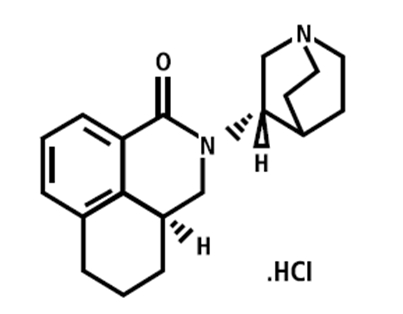
Palonosetron HCl is a white to off-white crystalline powder. It is freely soluble in water, soluble in propylene glycol, and slightly soluble in ethanol and 2-propanol.
Palonosetron HCl Injection is a sterile, clear, colorless, non-pyrogenic, non-buffered, hypotonic solution for intravenous administration. Palonosetron HCl Injection contains no preservative or chelating agent. Palonosetron HCl Injection is available as 2 mL single-dose vial.
Each 2 mL vial contains 0.25 mg palonosetron base equivalent to 0.28 mg palonosetron HCl, and water for intravenous administration.
The pH of the solution in the 2 mL vial is 6.5 to 8.5.
12 CLINICAL PHARMACOLOGY
12.1 Mechanism of Action
Palonosetron is a 5-HT3 receptor antagonist with a strong binding affinity for this receptor and little or no affinity for other receptors.
Cancer chemotherapy may be associated with a high incidence of nausea and vomiting, particularly when certain agents, such as cisplatin, are used. 5-HT3 receptors are located on the nerve terminals of the vagus in the periphery and centrally in the chemoreceptor trigger zone of the area postrema. It is thought that chemotherapeutic agents produce nausea and vomiting by releasing serotonin from the enterochromaffin cells of the small intestine and that the released serotonin then activates 5-HT3 receptors located on vagal afferents to initiate the vomiting reflex.
12.2 Pharmacodynamics
Cardiac Electrophysiology
The effect of intravenous palonosetron HCl on blood pressure, heart rate, and ECG parameters including QTc were comparable to intravenous ondansetron and dolasetron in CINV clinical trials. In non-clinical studies palonosetron possesses the ability to block ion channels involved in ventricular de- and re-polarization and to prolong action potential duration.
The effect of palonosetron on QTc interval was evaluated in a double blind, randomized, parallel, placebo and positive (moxifloxacin) controlled trial in adult men and women. The objective was to evaluate the ECG effects of intravenously administered palonosetron HCl at single doses of 0.25, 0.75 or 2.25 mg in 221 healthy subjects. At a dose 9 times the maximum recommended dose, palonosetron did not prolong the QT interval to any clinically relevant extent.
12.3 Pharmacokinetics
After intravenous dosing of palonosetron HCl in healthy subjects and cancer patients, an initial decline in plasma concentrations is followed by a slow elimination from the body. Mean maximum plasma concentration (Cmax) and area under the concentration-time curve (AUC0-∞) are generally dose-proportional over the dose range of 0.3 to 90 mcg/kg in healthy subjects and in cancer patients. Following a single intravenous dose of palonosetron HCl at 3 mcg/kg (or 0.21 mg/70 kg) to six cancer patients, the mean (±SD) maximum plasma concentration was estimated to be 5630 ± 5480 ng/L and the mean AUC was 35.8 ± 20.9 h•mcg/L.
Following intravenous administration of palonosetron HCl 0.25 mg once every other day for 3 doses in 11 cancer patients, the mean increase in plasma palonosetron concentration from Day 1 to Day 5 was 42 ± 34%. Following intravenous administration of palonosetron HCl 0.25 mg once daily for 3 days in 12 healthy subjects, the mean (±SD) increase in plasma palonosetron concentration from Day 1 to Day 3 was 110 ± 45%.
Distribution
Palonosetron has a volume of distribution of approximately 8.3 ± 2.5 L/kg. Approximately 62% of palonosetron is bound to plasma proteins.
Elimination
After a single intravenous dose of 10 mcg/kg [14C]-palonosetron HCl, approximately 80% of the dose was recovered within 144 hours in the urine with palonosetron representing approximately 40% of the administered dose. In healthy subjects, the total body clearance of palonosetron was 0.160 ± 0.035 L/h/kg and renal clearance was 0.067 ± 0.018 L/h/kg. The mean terminal elimination half-life is approximately 40 hours.
Metabolism
Palonosetron is eliminated by multiple routes with approximately 50% metabolized to form two primary metabolites: N-oxide-palonosetron and 6-S-hydroxy-palonosetron. These metabolites each have less than 1% of the 5-HT3 receptor antagonist activity of palonosetron. In vitro metabolism studies have suggested that CYP2D6 and to a lesser extent, CYP3A4 and CYP1A2 are involved in the metabolism of palonosetron. However, clinical pharmacokinetic parameters are not significantly different between poor and extensive metabolizers of CYP2D6 substrates.
Excretion
Palonosetron is partially eliminated from the body through renal excretion.
Specific Populations
Renal Impairment
Mild to moderate renal impairment does not significantly affect palonosetron pharmacokinetic parameters. Total systemic exposure increased by approximately 28% in patients with severe renal impairment relative to healthy subjects. This increase is not considered clinically meaningful.
Hepatic Impairment
Hepatic impairment does not significantly affect total body clearance of palonosetron compared to the healthy subjects.
Race/Ethnicity
The pharmacokinetics of palonosetron were characterized in twenty-four healthy Japanese subjects over the dose range of 3 to 90 mcg/kg. Total body clearance was 25% higher in Japanese subjects compared to Whites; however, no dose adjustment is required. The pharmacokinetics of palonosetron in Blacks has not been adequately characterized.
Drug Interaction Studies
In vitro studies indicated that palonosetron is not an inhibitor of CYP1A2, CYP2A6, CYP2B6, CYP2C9, CYP2D6, CYP2E1 and CYP3A4/5 (CYP2C19 was not investigated) nor does it induce the activity of CYP1A2, CYP2D6, or CYP3A4/5. Therefore, the potential for clinically significant drug interactions with palonsetron appears to be low.
Dexamethasone
Coadministration of 0.25 mg palonosetron HCl and 20 mg dexamethasone administered intravenously in healthy subjects revealed no pharmacokinetic drug-interactions between palonosetron and dexamethasone.
Oral Aprepitant
In an interaction study in healthy subjects where a single 0.25 mg intravenous dose of palonosetron HCl was administered on day 1 and oral aprepitant for 3 days (125 mg/80 mg/80 mg), the pharmacokinetics of palonosetron were not significantly altered (AUC: no change, Cmax: 15% increase).
Metoclopramide
A study in healthy subjects involving a single 0.75 mg intravenous dose of palonosetron HCl and steady state oral metoclopramide (10 mg four times daily) demonstrated no significant pharmacokinetic interaction.
Corticosteroids, Analgesics, Antiemetics/Antinauseants, Antispasmodics and Anticholinergic Agents
In controlled clinical trials, palonosetron HCl has been safely administered with corticosteroids, analgesics, antiemetics/antinauseants, antispasmodics and anticholinergic agents.
13 NONCLINICAL TOXICOLOGY
13.1 Carcinogenesis, Mutagenesis, Impairment of Fertility
In a 104-week carcinogenicity study in CD-1 mice, animals were treated with oral doses of palonosetron HCl at 10, 30 and 60 mg/kg/day. Treatment with palonosetron was not tumorigenic. The highest tested dose produced a systemic exposure to palonosetron (plasma AUC) of about 150 to 289 times the human exposure (AUC = 29.8 h•mcg/L) at the recommended intravenous dose of 0.25 mg. In a 104-week carcinogenicity study in Sprague-Dawley rats, male and female rats were treated with oral doses of 15, 30 and 60 mg/kg/day and 15, 45 and 90 mg/kg/day, respectively. The highest doses produced a systemic exposure to palonosetron (plasma AUC) of 137 and 308 times the human exposure at the recommended dose. Treatment with palonosetron HCl produced increased incidences of adrenal benign pheochromocytoma and combined benign and malignant pheochromocytoma, increased incidences of pancreatic Islet cell adenoma and combined adenoma and carcinoma and pituitary adenoma in male rats. In female rats, it produced hepatocellular adenoma and carcinoma and increased the incidences of thyroid C-cell adenoma and combined adenoma and carcinoma.
Palonosetron was not genotoxic in the Ames test, the Chinese hamster ovarian cell (CHO/HGPRT) forward mutation test, the ex vivo hepatocyte unscheduled DNA synthesis (UDS) test or the mouse micronucleus test. It was, however, positive for clastogenic effects in the Chinese hamster ovarian (CHO) cell chromosomal aberration test.
Palonosetron HCl at oral doses up to 60 mg/kg/day (about 1894 times the recommended human intravenous dose based on body surface area) was found to have no effect on fertility and reproductive performance of male and female rats.
14 CLINICAL STUDIES
The safety and efficacy of Palonosetron HCl Injection have been established based on adequate and well-controlled adult studies of another intravenous formulation of palonosetron HCl in chemotherapy induced nausea and vomiting. Below is a display of the results of these adequate and well-controlled studies of palonosetron HCl.
14.1 Chemotherapy-Induced Nausea and Vomiting
Efficacy of a single intravenous dose of palonosetron HCl in preventing acute and delayed nausea and vomiting induced by both moderately and highly emetogenic chemotherapy was studied in 4 trials. In these double-blind trials, complete response rates (no emetic episodes and no rescue medication) and other efficacy parameters were assessed through at least 120 hours after administration of chemotherapy. The safety and efficacy of palonosetron HCl in repeated courses of chemotherapy was also assessed.
Moderately Emetogenic Chemotherapy:
Two double-blind trials (Study 1 and Study 2) involving 1132 patients compared a single intravenous dose of palonosetron HCl with either a single intravenous dose of ondansetron (Study 1) or dolasetron (Study 2) given 30 minutes prior to moderately emetogenic chemotherapy including carboplatin, cisplatin ≤ 50 mg/m², cyclophosphamide < 1500 mg/m², doxorubicin > 25 mg/m², epirubicin, irinotecan, and methotrexate > 250 mg/m². Concomitant corticosteroids were not administered prophylactically in Study 1 and were only used by 4 to 6% of patients in Study 2. The majority of patients in these studies were women (77%), White (65%) and naïve to previous chemotherapy (54%). The mean age was 55 years.
Highly Emetogenic Chemotherapy:
A double-blind, dose-ranging trial evaluated the efficacy of single-dose intravenous palonosetron from 0.3 to 90 mcg/kg (equivalent to < 0.1 mg to 6 mg fixed dose) in 161 chemotherapy-naïve adult cancer patients receiving highly emetogenic chemotherapy (either cisplatin ≥ 70 mg/m² or cyclophosphamide >1100 mg/m²). Concomitant corticosteroids were not administered prophylactically. Analysis of data from this trial indicates that 0.25 mg is the lowest effective dose in preventing acute nausea and vomiting induced by highly emetogenic chemotherapy.
A double-blind trial involving 667 patients compared a single intravenous dose of palonosetron HCl with a single intravenous dose of ondansetron (Study 3) given 30 minutes prior to highly emetogenic chemotherapy including cisplatin ≥ 60 mg/m², cyclophosphamide > 1500 mg/m², and dacarbazine. Corticosteroids were co-administered prophylactically before chemotherapy in 67% of patients. Of the 667 patients, 51% were women, 60% White, and 59% naïve to previous chemotherapy. The mean age was 52 years.
Efficacy Results:
The antiemetic activity of palonosetron HCl was evaluated during the acute phase (0-24 hours) [Table 3], delayed phase (24-120 hours) [Table 4], and overall phase (0-120 hours) [Table 5] post-chemotherapy in Studies 1, 2 and 3.
Table 3: Prevention of Acute Nausea and Vomiting (0-24 hours): Complete Response Rates
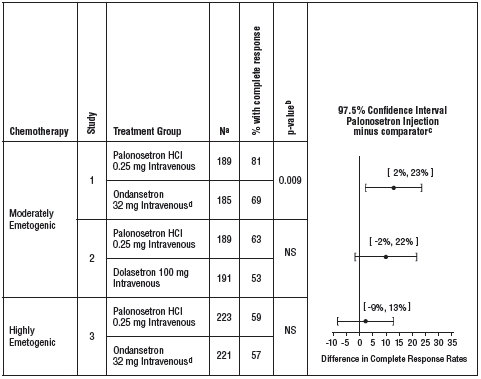
a Intent-to-treat cohort
b 2-sided Fisher’s exact test. Significance level α=0.025.
c These studies were designed to show non-inferiority. A lower bound greater than –15% demonstrates non-inferiority between palonosetron HCl and comparator.
d Ondansetron 32 mg intravenous was used in the clinical trial. Although this dose was used in the trial, this is no longer the currently recommended dose. Refer to the ondansetron prescribing information for the current recommended dose.
These trials show that palonosetron HCl was effective in the prevention of acute nausea and vomiting associated with initial and repeat courses of moderately and highly emetogenic cancer chemotherapy.
In Study 3, efficacy was greater when prophylactic corticosteroids were administered concomitantly. Clinical superiority over other 5-HT3 receptor antagonists has not been adequately demonstrated in the acute phase.
Table 4: Prevention of Delayed Nausea and Vomiting (24-120 hours): Complete Response Rates
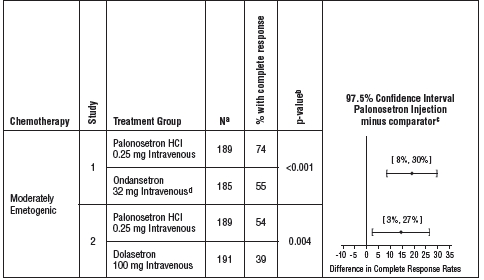
a Intent-to-treat cohort
b 2-sided Fisher’s exact test. Significance level α=0.025.
c These studies were designed to show non-inferiority. A lower bound greater than –15% demonstrates non-inferiority between palonosetron HCl and comparator.
d Ondansetron 32 mg intravenous was used in the clinical trial. Although this dose was used in the trial, this is no longer the currently recommended dose. Refer to the ondansetron prescribing information for the current recommended dose.
These trials show that palonosetron HCl was effective in the prevention of delayed nausea and vomiting associated with initial and repeat courses of moderately emetogenic chemotherapy.
Table 5: Prevention of Overall Nausea and Vomiting (0-120 hours): Complete Response Rates
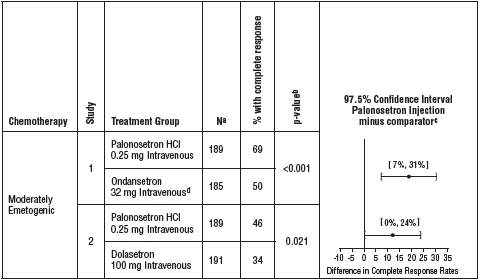
a Intent-to-treat cohort
b 2-sided Fisher’s exact test. Significance level α=0.025.
c These studies were designed to show non-inferiority. A lower bound greater than –15% demonstrates non-inferiority between palonosetron HCl and comparator.
d Ondansetron 32 mg intravenous was used in the clinical trial. Although this dose was used in the trial, this is no longer the currently recommended dose. Refer to the ondansetron prescribing information for the current recommended dose.
These trials show that palonosetron HCl was effective in the prevention of nausea and vomiting throughout the 120 hours (5 days) following initial and repeat courses of moderately emetogenic cancer chemotherapy.
16 HOW SUPPLIED/STORAGE AND HANDLING
How Supplied
Palonosetron Hydrochloride Injection is clear and colorless and is supplied in single-dose vials as follows:
NDC Number Strength Package
0143-9513-01 0.25 mg/2 mL (0.125 mg/mL) 1 vial/carton
Storage
- Store at 20° to 25°C (68° to 77°F); [Excursions permitted to 15° to 30°C (59° to 86°F)].
- Protect from freezing.
- Protect from light.
17 PATIENT COUNSELING INFORMATION
Advise patients to read the FDA-approved patient labeling (Patient Information).
Hypersensitivity Reactions
Advise patients that hypersensitivity reactions, including anaphylaxis, have been reported in patients with or without known hypersensitivity to other 5-HT3 receptor antagonists. Advise patients to seek immediate medical attention if any signs or symptoms of a hypersensitivity reaction occur with administration of Palonosetron HCl Injection [see Warnings and Precautions (5.1)].
Serotonin Syndrome
Advise patients of the possibility of serotonin syndrome, especially with concomitant use of Palonsetron HCl Injection and another serotonergic agent such as medications to treat depression and migraines. Advise patients to seek immediate medical attention if the following symptoms occur: changes in mental status, autonomic instability, neuromuscular symptoms with or without gastrointestinal symptoms [see Warnings and Precautions (5.2)].
Manufactured by:
Exela Pharma Sciences LLC
Lenoir, NC 28645 USA
Distributed by:
WEST-WARD
A HIKMA COMPANY
Eatontown, NJ 07724 USA
9513-0617-00
Issued June 2017
Patient Information
Palonosetron Hydrochloride Injection (PAL-oh-NOE-se-tron HYE-droe-KLOR-ide)
for intravenous use
Read this Patient Information before you receive Palonosetron Hydrochloride Injection and each time you receive Palonosetron Hydrochloride Injection. There may be new information. This information does not take the place of talking with your doctor about your medical condition or your treatment.
What is Palonosetron Hydrochloride Injection?
Palonosetron Hydrochloride Injection is a prescription medicine called an “antiemetic.”
Palonosetron Hydrochloride Injection is used in adults to help prevent the nausea and vomiting that happens right away or later with certain anti-cancer medicines (chemotherapy).
This product has not been approved for use in children to help prevent nausea and vomiting after chemotherapy.
Who should not receive Palonosetron Hydrochloride Injection?
Do not receive Palonosetron Hydrochloride Injection if you are allergic to palonosetron hydrochloride or any of the ingredients in Palonosetron Hydrochloride Injection. See the end of this leaflet for a complete list of ingredients in Palonosetron Hydrochloride Injection.
What should I tell my doctor before receiving Palonosetron Hydrochloride Injection?
Before receiving Palonosetron Hydrochloride Injection, tell your doctor about all of your medical conditions, including if you:
• have had an allergic reaction to another medicine for nausea or vomiting
• are pregnant or plan to become pregnant. It is not known if Palonosetron Hydrochloride Injection will
harm your unborn baby.
• are breastfeeding or plan to breastfeed. It is not known if Palonosetron Hydrochloride Injection passes into your breast milk or if it will affect your baby or your breast milk. Talk to your doctor about the best way to feed your baby if you will receive Palonosetron Hydrochloride Injection.
Tell your doctor about all of the medicines you take including prescription and over-the-counter medicines, vitamins and herbal supplements.
Palonosetron Hydrochloride Injection and certain other medicines can affect each other, causing serious side effects.
How will I receive Palonosetron Hydrochloride Injection?
• Palonosetron Hydrochloride Injection will be given to you in your vein by I.V. (intravenous) injection.
• Palonosetron Hydrochloride Injection is usually given about 30 minutes before you receive your anti-cancer medicine (chemotherapy).
What are the possible side effects of Palonosetron Hydrochloride Injection?
Palonosetron Hydrochloride Injection may cause serious side effects, including:
• Serious allergic reactions. Palonosetron Hydrochloride Injection can cause allergic reactions that can sometimes be serious. Tell your doctor or nurse right away if you have any of the following symptoms of a serious allergic reaction with Palonosetron Hydrochloride Injection:
o hives
o swollen face
o breathing trouble
o chest pain
• Serotonin Syndrome. A possible life-threatening problem called serotonin syndrome can happen with medicines called 5-HT3 receptor antagonists, including Palonosetron Hydrochloride Injection, especially when used with medicines used to treat depression and migraine headaches called serotonin reuptake inhibitors (SSRIs), serotonin and norepinephrine reuptake inhibitors (SNRIs), monoamine oxidase inhibitors (MAOIs) and certain other medicines. Tell your doctor or nurse right away if you have any of the following symptoms of serotonin syndrome:
o agitation, seeing things that are not there (hallucinations), confusion, or coma
o fast heartbeat or unusual and frequent changes in your blood pressure
o dizziness, sweating, flushing, or fever
o tremors, stiff muscles, muscle twitching, overactive reflexes, or loss of coordination
o seizures
o nausea, vomiting, or diarrhea
The most common side effects of Palonosetron Hydrochloride Injection in adults are headache and constipation.
These are not all the possible side effects of Palonosetron Hydrochloride Injection. Call your doctor for medical advice about side effects. You may report side effects to FDA at 1-800-FDA-1088.
General information about the safe and effective use of Palonosetron Hydrochloride Injection Medicines are sometimes prescribed for purposes other than those listed in a Patient Information leaflet. You can ask your doctor or pharmacist for information about Palonosetron Hydrochloride Injection that is written for health professionals.
What are the ingredients in Palonosetron Hydrochloride Injection?
Active ingredient: palonosetron hydrochloride
Inactive ingredient: water for intravenous administration
Rx Only
Manufactured by: Exela Pharma Sciences LLC, Lenoir, NC 28645 USA
Distributed by: WEST-WARD, A HIKMA COMPANY, Eatontown, NJ 07724 USA
For Product Inquiry call 1-877-845-0689.
This Patient Information has been approved by the U.S. Food and Drug Administration.
9513-0617-00
Issued June 2017
PRINCIPAL DISPLAY PANEL
NDC 0143-9513-01 Rx only
Palonosetron
HCl Injection
0.25 mg/2 mL
(0.125 mg/mL)
For Intravenous Injection Only
2 mL Single Dose Sterile Vial
Check concentration prior to
preparation. See package insert
for complete instructions.
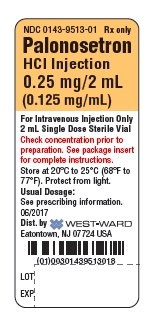
NDC 0143-9513-01 Rx only
Palonosetron
HCl Injection
0.25 mg/2 mL
(0.125 mg/mL)
For Intravenous
Injection Only
2 mL Single
Dose Sterile Vial
Check concentration prior to
preparation. See package insert
for complete instructions.

